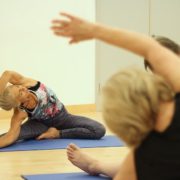5 Ways Regenerative Shockwave Therapy Speeds Healing and Boosts Mobility for people aged 50+
Regenerative Shockwave Therapy
Arthritis, degenerative joint disease, and general wear and tear of our bodies are all a normal part of aging – and these things tend to become more problematic once we get into our 50’s and beyond.
A lot of people falsely believe that as these ailments start to rear their ugly heads, it means you need to slow down, or even cease, some of your favorite activities. This couldn’t be farther from the truth. But as you get older, what is true is that you’re probably going to need some aid and assistance to keep doing all the activities you love – especially if you’ve had an injury.
Aside from mastering the basics… drink plenty of water, get adequate sleep, fuel your body with wholesome nutritious food, and exercise/move daily… There is something else I’ve found that can really make a difference in how active and mobile you’re able to get (and stay) once you’ve hit your fifties. It’s called regenerative shockwave therapy – a treatment that utilizes high-energy “shock waves” (or soundwaves) to trigger a biological response that helps to aid and accelerate the healing process of your soft tissue (anything that isn’t bone). I only came across this revolutionary technology a few months ago. And while I was initially skeptical – I’ve since become a huge fan. Why? It’s safe and non-invasive, it aids the body’s natural healing process, it’s backed by research, and I’ve seen it work remarkably well to help with pain relief and soft tissue healing.
Here are 5 ways that regenerative shockwave therapy is helping injured people (especially those aged 50+) heal faster and boost their mobility:
1. Pain Management:
One of the main reasons people reduce their physical activity is due to pain. But movement and exercise are actually an essential component (in most cases) for pain relief. But let’s face it, when you hurt, you’re just not as motivated to move. This is where regenerative shockwave therapy comes in. It quickly penetrates deep into your soft tissue to help bring blood flow and healing properties to a targeted area to reduce pain. And it keeps working even after the treatment is over. As your pain reduces, you feel more confident to move and resume your favorite physical activities faster.
2. Improved Mobility:
As you approach age 50 and beyond – you may notice your joints naturally becoming stiffer. Stiffness on its own might not seem like a big deal – but it becomes a problem when it leads to compensatory movement patterns – which can eventually lead to pain. Shockwave therapy helps to promote collagen production, the protein responsible for maintaining the suppleness and flexibility of your soft tissue. Good mobility helps you move better and feel better – and shockwave therapy can be a valuable companion in this process.
3. Blood Flow Stimulation:
Good blood flow and circulation are essential components to quick healing of any soft tissue injury. Shockwave therapy aids in this process with vasodilation – ensuring that the injured or degenerated tissue receives a higher influx of nutrients – which speeds up the recovery process. As we get older, the integrity of our soft tissue can suffer, so anything that can stimulate blood flow is going to help you heal – and get you back to your favorite activities faster.
4. Reduces Scar Tissue:
It’s not uncommon to meet folks in their 50’s (and beyond) with at least one or two orthopedic surgeries under their belt. While I consistently advocate against resorting to surgery, there are times when it’s necessary and beneficial. But a mismanaged scar can ruin everything. Scars don’t act like your original tissue and if they aren’t managed properly – will cause mobility restrictions that worsen over time. Shockwave therapy can help to break down scar tissue and stimulate the production of new, healthy tissue – which can restore any discomfort or dysfunction that the scar was causing – getting you back to your activities faster.
5. Accelerated Recovery:
At the end of the day, and for all the reasons already stated, shockwave therapy helps to speed up your body’s own natural healing process and thus – recovery. Consider it a companion and “best friend” to any rehabilitation protocol. With increased blood flow, reduction of scar tissue, and improved pain and mobility – you tolerate things with more ease and can progress more quickly. When you’re younger – you have a lot of this naturally on your side already. But as we age, everything slows down, including our body’s natural recovery processes. Shockwave therapy steps in to fill this gap so you don’t have to miss out for too long on your favorite physical activities.
If you’re currently injured and avoiding exercise – consider adding regenerative shockwave therapy into the mix to help reduce your pain, improve your mobility, and get you back to your favorite activities faster.
To learn more about Regenerative Shockwave Therapy and other benefits, CLICK HERE. Who knows, it could be the missing link to your healing that you didn’t even know existed.
Dr. Carrie Jose, Physical Therapist and Pilates expert, owns CJ Physical Therapy & Pilates in Portsmouth and writes for Seacoast Media Group. To get in touch, email her at [email protected] or CLICK HERE to talk to one of our specialists.












